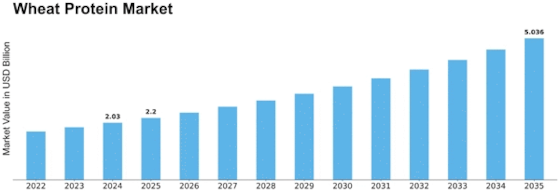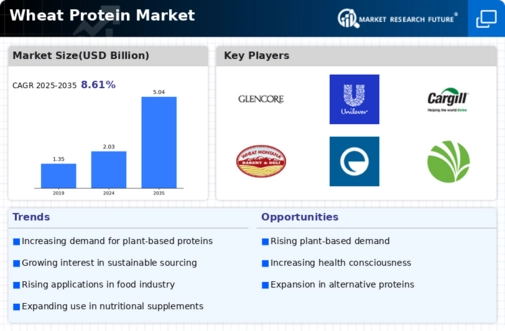Wheat Protein Size
Wheat Protein Market Growth Projections and Opportunities
The Wheat Protein market is shaped by a multitude of factors that collectively influence its growth and market dynamics. One of the primary drivers is the increasing global demand for plant-based proteins, driven by a growing awareness of health and sustainability. Wheat protein, derived from wheat grains, has emerged as a significant player in the plant-based protein landscape, appealing to consumers seeking alternatives to animal-based proteins. The market benefits from wheat protein's versatile applications in various food products, including bakery goods, plant-based meat substitutes, and nutritional supplements. The wheat protein market is projected to grow at a 6.2% CAGR from 2020 to 2027, reaching a value of USD 2271.76 million.
Technological advancements and innovations contribute substantially to the Wheat Protein market. Advances in extraction methods and processing technologies have improved the quality and functionality of wheat protein isolates and concentrates. This allows for the development of products with enhanced texture, taste, and nutritional profiles, catering to the evolving preferences of consumers. The continuous research and development in wheat protein applications foster its utilization across a broad spectrum of food and beverage categories, contributing to market expansion.
Globalization and international trade play a pivotal role in the Wheat Protein market. As the popularity of plant-based diets transcends geographical boundaries, there is a growing demand for wheat protein on a global scale. Companies operating in the market must navigate diverse regulatory landscapes and cater to varying consumer preferences in different regions. Additionally, the exchange of culinary influences and dietary trends across borders contributes to the versatility and adaptability of wheat protein in various cuisines and food applications.
The focus on health and wellness is another significant factor influencing the Wheat Protein market. With consumers increasingly prioritizing their well-being, there is a growing interest in products that offer both nutritional benefits and sustainable sourcing. Wheat protein, rich in essential amino acids, is recognized as a wholesome and plant-based protein source. Moreover, the sustainable nature of wheat cultivation contributes to the market's appeal, aligning with environmentally conscious consumer choices.
Sustainability considerations and environmental awareness represent emerging factors in the Wheat Protein market. As consumers seek environmentally friendly options, the sustainable sourcing of wheat and eco-friendly production methods become critical for companies in the market. The wheat protein industry's potential to utilize wheat by-products and residues contributes to a more circular and sustainable approach in protein production, addressing concerns related to waste and resource utilization.
Despite the positive trends, challenges exist in the Wheat Protein market. The potential for gluten intolerance and allergies limits the consumer base for wheat protein products. Additionally, competition from other plant-based proteins and the need for continuous innovation to meet evolving consumer preferences pose challenges for market players.


















Leave a Comment